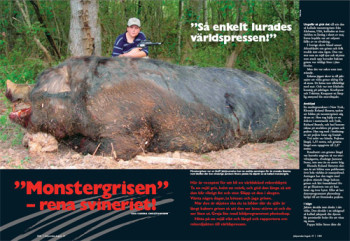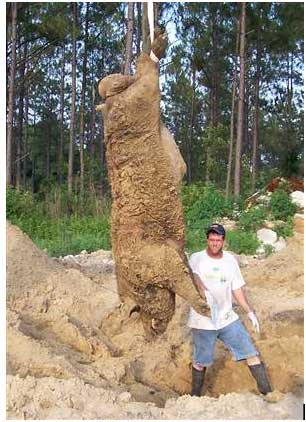
Swedish publication, Jaktjournalen, featured reporter's analysis of American based Hogzilla II hoax.
The writer is Swedish freelance reporter, Carina Christiansen. She currently lives in Edmonton, Canada and writes stories for several hunters’ magazines in Sweden, Norway and Germany.
“The editor in Sweden contacted me to ask if I wanted to do a story on a huge hog shot by a child in Alabama. The story and the image had been published in the Swedish tabloid Aftonbladet, and he wanted an update for his readers,” says Christiansen.
She went to work right away but, she says, she got a strange feeling when she began looking into the story.
“First the size of the hog on the image. It was just too big to make sense; if true it would have been a complete freak of nature. Then was the information that they had made 300 kilos of sausage. I went to farm school in Sweden as a teenager and I know that you have to geld male pigs, otherwise the meat stinks [called “boar taint”], and you cannot eat it.”
The second thing that made her suspicious was the website, Monsterpig.com, which was so quickly up and running. “Other trophy hunters are usually very humble people, very quiet in a way. They live for the hunt and take on huge costs and efforts to go to remote and harsh places on earth to find the largest living animals. Very often they want to stay anonymous, and you have to work hard to get their contact information.” [See her text box on trophy hunting below.]
She says this case was different – very different. On their website, for instance, was information about the different countries the story had been published. Even more strange was the publicized connection to an “under-development” horror movie about the original monster pig, The Legend of Hogzilla. She Googled the story for more information and ended up at our website, iMediaEthics.org. There, she read about the analysis of the image done by retired NYU physicist Richard Brandt. Brandt had found that if the measurements of pig were correct, the hunter was only one meter tall.
“You can’t get more evidence of a smelly story than that,” she says.
She contacted her Swedish editor and told him she was sorry, but the story could not be done because it was partly incorrect. Christiansen told her editor in the course of her research she’d found two other “record pigs” shot in 2004 and January 2007. She proposed that the new story be written about all three pigs – and the facts and myths surrounding all of them.
“Because of all he press coverage I realized that there is a huge interest out there for large hogs. Maybe because we all grow up with pig fairytales, we eat bacon, and we can relate to them, and think we know them to some degree.”
In the August 2007 edition of Swedish hunters’ magazine, Jaktjournalen, Christiansen filed her story with the headline, “Shot by an Eleven Year-Old: This is how easy it is to fool the world press.”
Here it is, translated into English:
THE MONSTER PIGS –– STORIES THAT SMELL–– This is how easy it is to fool the world press
The following are steps one should follow to become a world famous hunter.
- Take a decent sized piglet, preferably a dark one, and feed it until it grows fat and big.
- Let it loose in the outdoors.
- Wait a couple of days.
- Then grab a gun and go hunt the pig.
- Once you’ve finally killed the animal, take photographs in which you are standing far behind the pig so it looks even larger. For more drama, adjust the picture in the computer program Photoshop.
- Think of a weight and length dramatic enough to demand public attention and report it to the world press.
- Sell images of the dead pig to media outlets for a large sum.
Jackpot.
So went the story of a “monster pig” recently killed in Alabama. The tale was delivered late last month by the news agency Associated Press, the TV news channel CNN, and many other international media outlets. In Sweden, it was published by the tabloid, Aftonbladet.
The story was made more compelling by the fact that the hunter was an eleven-year old boy. However, certain things about the story were not quite right. Skeptical hunters, for example, wrote on chat sites that wild hogs never grow that large in the wild because they just can’t find enough feed. Others asked about the clothing on the pig hunters. Shorts and t-shirts? Not a common outfit for big game hunters out in the wilderness.
A media critic from New York and [publisher of the] website StinkyJournalism.org, Rhonda Roland Shearer, asked NYU physicist Dr. Richard Brandt to calculate the size of the boy compared to the huge hog in front of him. Two measurements were known: the boy’ s length, 1.55 m, and the hog’s, said to be 2.87 m. In the calculations, he also compensated for the appearance in the photo that the boy is slightly leaning forward.
The result: If the length of the hog were correct, the record big game hunter was not more than one meter tall.
His conclusion is that the image, which has been delivered all over the world, is manipulated. Either the boy is placed far behind the pig to appear smaller, or Photoshop has been used to make the hunter smaller in comparison to the pig.
There’s more: The hunt itself did not take place out in the wild. The whole thing happened in a fenced game park where the animals are fed protein-rich feed to make them grow big.
Indeed, the boy’s father, Mike Stone, took his son there. The story of the killing of a giant pig would be even greater with an eleven year-old hero.
The boy shot his .50 calibre Smith & Wesson and missed his target many times. Mike Stone and two hunting guides from the park were prepared with rifles aimed at the animal in case it attacked. Critical hunters have commented that such a gun is not easy to handle for a child. No less than eight bullets were used before the hog finally went down after a three-hour long hunt.
After the pig was dead Mike Stone quickly put up a website for the little hunter. On the family’s website, monsterpig.com, we are told that the boy was offered a role in a horror movie about a monster pig terrorizing a town. The movie’s title is [The Legend of] Hogzilla, a play on Godzilla, a well-known Japanese monster film.
When we continue to root around in the story, even more strange facts appear. According to Rhonda Shearer, the measurements of this pig’s length has recently changed. Mike Stone says that the length was measured when the animal was hanging by a foot from a tractor. Stone says he measured the animal from the end of the foot to the end of the nose. But according to experts, that kind of measurement would not be accepted in any established circles of trophy hunters.
(Trophy hunters, by the way, would not care at all about these pig stories, as the game has to be harvested “fair” in the wild. See trophy rules below.)
No independent witnesses saw the pig. Everything we know about the size of the pig, in fact, comes from Mike Stone. The guides cannot be considered independent as the game park is sponsoring Mike Stone’s monster pig website.
We phoned Clay County Farmers Exchange in Lineville where the pig was weighed, to talk to Jeff Kinder who was quoted in the original AP story. “No, I never saw the pig,” says Kinder. “I just gave them the keys to the room where we kept the scale.”

Hunter, Chris Griffin, with original “Hogzilla” monster hog, shot in 2004.
“There seems to be an enormous interest for big hogs,” says Brad Bailey, journalist on the hunting magazine Georgia Outdoor News.
The Monster Pig is not the first big pig recently taken in the region. A big hog was shot in the state of Georgia 2004. Weight and length was reported, and then the hog was buried really fast.
The press reported on the monster pig, which was soon dubbed Hogzilla. Six months later, National Geographic made a documentary on Hogzilla and had scientists dig it up to take their own measurements.
The figures decreased dramatically following their report. “They had said it was 3.7 meters long, but we found it was only 2.0 metres of you included the tail which was cut,” says Jack Mayer, one of the hog researchers hired by National Geographic.
The weight was originally reported as 452 kilograms. Jack Mayer said it was probably closer to 363 kilograms. “It was still a big pig, but not as big as they had said,” says Jack Mayer.
Jack Mayer says its feet had clear signs of tearing from concrete floors [indicating it had been raised in captivity]. Like the Stone’s Monster Pig, Hogzilla had also been shot in a game park and given feed to grow fat. “This is not hunting. This is like going into your neighbour’s field and shooting one of his cows,” says Jack Mayer.
In spite of these two stinky pig stories, there is one giant pig that was measured in an honest way. The pig was shot in Fayette County in Georgia, USA, in January 2007.
“I have checked the measurements and they are correct,” says Jack Mayer.
Bill Coursey of Georgia, who had brought down the giant hog, says he usually he hunts deer on his own land. One day in January, after his son and wife had driven home, they claimed to have seen a huge hog in the neighbour’s yard. The neighbour wanted it killed. Bill Coursey had a broken leg and was home from his work as a fire fighter.
 |
|
Bill Coursey of Georgia with “giant hog” he shot in January 2007.
|
He grabbed his rifle, a Ruger 7mm/.08, and climbed into his pick up truck.
The black hog stood quietly on the lawn and munched away under a big oak tree. “I didn’t want it to attack and or run, because I could not move very well with my leg,” says Bill Coursey. He put one bullet behind the animal’s right ear. The hog backed up one step, sat down, and fell.
“My story is not a really good hunting story,” admits Bill Coursey, who stood just one step from his pickup and leaned his crutches against the vehicle.
Bill Coursey knew that the first “Hogzilla” had been disproved with fake measurements – so he wanted this one measured with witnesses.
He had it lifted up onto the bed of the pickup and drove it to a garbage station. He first measured the weight of the pig in the truck. He then had a tractor lift the pig off the bed, and took the weight of the pickup truck without the pig.
He documented the weight: 500 kilograms.
After the hunt, he heard stories of his pig “terrorizing” the neighbourhood. There were no attacks though. The pig, however, would do things such as destroy lawns and walk up on porches that couldn’t support the weight.
What it had been eating to maintain its size is mystery. Life in the wild is not usually that rich.
A wild hog in the USA rarely becomes heavier than 270 kilograms, according to Jack Mayer.
Plain boars – animals with no mixed domestic blood – don’t get heavier than 140-160 kilograms, he says.
The pigs that run free in Georgia and other places in the USA are often of very mixed bloodlines. Some of are feral – escapees that have adapted to life in the wild. Some of them are crosses between wild boars and domestic breeds. Some are merely tame pigs that found holes in fences.
Jack Mayer has taken DNA from Bill Coursey’s pig and the answer has not arrived as to what kind of pig it is. But Jack Mayer believes it is a pig that recently escaped. “The ears had no markings of fights which is common for wild hogs,” he says.
SPECIAL REPORT Exclusive: Follow the Bacon: Part II
12 year old faces possible Grand Jury charges for animal cruelty.Hog Washed!: Part I
iMediaEthics investigation debunks AP and FOX News: “Giant Hog with Small Boy” Photo
-
- Alabama’s Monster Pig Hoax, one year later
Consequences of infamous youth pig kill still being played out
- Alabama’s Monster Pig Hoax, one year later
-
- Hyped Hog Hits Speedbump on Way to Fame:
Will Monster Pig and Boy Photo continue to fetch $500 a pop?
- Hyped Hog Hits Speedbump on Way to Fame:
-
- Mike Stone, Unturned:
Rhonda Shearer’s response to monster pig’s rant
- Mike Stone, Unturned:
-
- Pig Tales:
When news becomes a game, everyone loses.
- Pig Tales:
-
- Big Pig Smack Down: Big Norm’s Owner Weighs In
Says Monster Pig a Fraud Like Hogzilla
- Big Pig Smack Down: Big Norm’s Owner Weighs In
-
- “The Monster Pig Photo’s a Fake”: Reader’s Comments
Exclusive Interview: With Kerry Dart, New York Farmer and Owner of World’s Largest Hog
- “The Monster Pig Photo’s a Fake”: Reader’s Comments
-
- INTERPORK: Swedish Publication Hunts Down American Hogzilla II Hoax
- [Comics for Media Reform] Associated Press Lets Monster Pig Photo Fly and “Monster Pig! But I’m Fred”
The ears, for example, says Meyer, were 23.8 cm long compared to maximum 16.5 cm in wild pigs.
Bill Coursey has learned firsthand about the intense interest in big hogs. When BBC London phoned he thought it was his mates from the fire station who had pulled a prank on him. Now he has his own collection of newspaper clips. He has even signed autographs, and gotten his own PR-contract with the [same horror filmmakers of] Monster Pig infamy.
Bill Coursey says it’s nice to have a little change from his typically calm days at the fire station.
| iMediaEthics commissioned Carina Christiansen to write the following report regarding trophy hunting rules.Monster Pig, Hogzilla I or II Need Not Apply–No world record weight or “trophy status” according to strict rulesNone of the “record” pigs mentioned here would ever make it into the record books for trophy animals. Real trophy animals are measured with strict, species-specific rules. There is also a strict code of ethics the hunter must follow to make his animal eligible.
An animal shot in a fenced game park, such as the “monster pig”, would not be eligible, according to the rules by Boone and Crockett, one of North America’s oldest and most renowned trophy club. “The animals have to be free ranging and not behind any escape proof fences,” says Ryan Hatfield from the Boone and Crockett club. In fact, no wild boars or pigs at all are allowed into their records. One reason is that the pigs that roam the continent are not native to North America and many of them cannot be considered truly wild animals. The hogs in the wild are often a mixture of different European breeds brought to North America as domestic pigs. Many escaped from their pens generations ago. Domestic means that they have long been bred for human use and have adapted genetically to the needs of humans. As long as pigs have been kept for their meat, they have been bred for their size. A farm pig is therefore approximately twice the size of a wild boar. The real trophy hunter who aims for a place in the Boone and Crockett record book has a number of rules to follow. The rules, as stated, are said to preserve an element of fair play in the relationship between hunter and prey. Here are a few: – Animals harvested in fenced (escape-proof) areas are not allowed – Hunter cannot see the animal from a plane or a helicopter, land and shoot; time has to pass between flying and hunting – Hunter cannot chase the animal on a motorized vehicle – Hunter cannot shoot a swimming animal, or if it is immobilized in deep snow – Hunters are also to follow local state or provincial rules that may exist, such as no hunting on a Sunday (a rule in parts of Alberta, Canada). There are eight different subspecies of moose in the world. Three of them have their own categories in the club – the Alaska-Yukon, the Shiras and the Canada. When a record moose is taken it never creates “tales” or “legends” – maybe because there are no discussions about its measurements. A professional measurer does the job openly, according the standards specific to moose. A moose is measured by the size of its antlers and the number of tags on the antlers. The weight is not a factor for one simple reason – there are no scales out in the wilderness. The discussion around the measurements around the “monster pig” from Alabama and its cousins may stem from the fact that there seems to have been no official measurers involved. But even if there is an honest try – how do you properly measure length? Does it include the back legs, which stretch out when the hog is hanging? Or do you start with the tail? And what if the tail is cut, as was the case for “Hogzilla”? It turns out that “Hogzilla” is actually in the record books at the trophy club Safari Club International—but only for the size of its tusks. They accept pigs that have escaped from pens if they have adapted to a life in the wild. (See Wikipedia report: “According to the examiners, Hogzilla’s tusks measured nearly 18 inches (46 cm), and nearly 16 inches (41 cm), which was a new record for North America.”) However, the hog specialist Jack Meyer tells us that tusks never grow that long on hogs in the wild. When examining the hog for National Geographic’s documentary, he saw signs of concrete floors on its feet and he figured the length of the tusks was another sign of a pen fed animal. In light of these facts, it seems that stories around the big pigs may continue to be quite messy. Bonne and Crockett Rules for what is not allowed: I. Spotting or herding game from the air, followed by landing in its vicinity for the purpose of pursuit and shooting; II. Herding or chasing with the aid of any motorized equipment; III. Use of electronic communication devices to guide hunters to game, artificial lighting, electronic light intensifying devices (night vision optics), sights with built-in electronic range-finding capabilities, thermal imaging equipment, electronic game calls or cameras/timers/motion tracking devices that transmit images and other information to the hunter; IV. Confined by artificial barriers, including escape-proof fenced enclosures; V. Transplanted for the purpose of commercial shooting; VI. By the use of traps or pharmaceuticals; VII. While swimming, helpless in deep snow, or helpless in any other natural or artificial medium; VIII. On another hunter’s license; IX. Not in full compliance with the game laws or regulations of the federal government or of any state, province, territory, or tribal council on reservations or tribal lands; |






